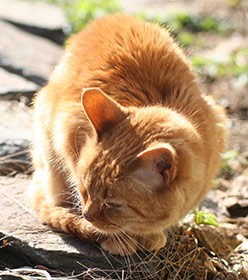Overview
Blastomycosis is a potentially deadly disease that is caused by a fungus found in damp soil where mold is present. This fungus likes wet or damp areas near swamps and lakes, and cats (and humans) who spend a lot of time in areas such as these are the most at risk.
A cat can get blastomycosis simply by inhaling the fungus that is hidden in the soil. The fungus travels to the lungs and can then spread to the rest of the body.
 Symptoms
Symptoms
It is important to bring your cat to a veterinarian as quickly as possible if he has blastomycosis.
Some of the most common signs are:
- Loss of appetite
- Coughing
- Difficulty breathing
- Fever
- Weight loss
- Skin lesions/abscesses
- Blindness and other eye problems
Diagnosis/Treatment
Not every cat that is exposed to this nasty fungus is infected, but those that do become infected need treatment in order to get better. An important aspect of diagnosing this infection is to know if your cat frequents the type of place that harbors the fungal organism, so providing your veterinarian with a detailed history of your pet’s activities is crucial.
Additionally, your veterinarian may want to test your cat for the following:
- A skin biopsy (if your cat has sores on his skin), or a biopsy of other affected tissues/organs to identify the causative agent
- Urine tests to rule out urinary tract infection and to evaluate the ability of the kidneys to concentrate urine
- Chemistry tests to evaluate kidney, liver, and pancreatic function, as well as sugar levels
- A complete blood count to rule out blood-related conditions
- Electrolyte tests to evaluate hydration status and to choose proper fluid supplements (if your pet is dehydrated)
- Radiographs
If your cat is diagnosed with blastomycosis, your veterinarian will discuss treatment options. These may include antifungal medications and other supportive treatments. Some antifungal drugs have the potential to cause kidney and liver damage, so your veterinarian will want to monitor your cat’s chemistry, urinalysis, and other laboratory values throughout treatment.
Prevention
Unfortunately, there is no vaccine or effective way to remove the fungus that causes blastomycosis. If your cat spends time outside in environments that are damp and wet and you see symptoms that may indicate he has a fungal infection, contact your veterinarian right away.
If you have any questions or concerns, you should always visit or call your veterinarian – they are your best resource to ensure the health and well-being of your pets.
